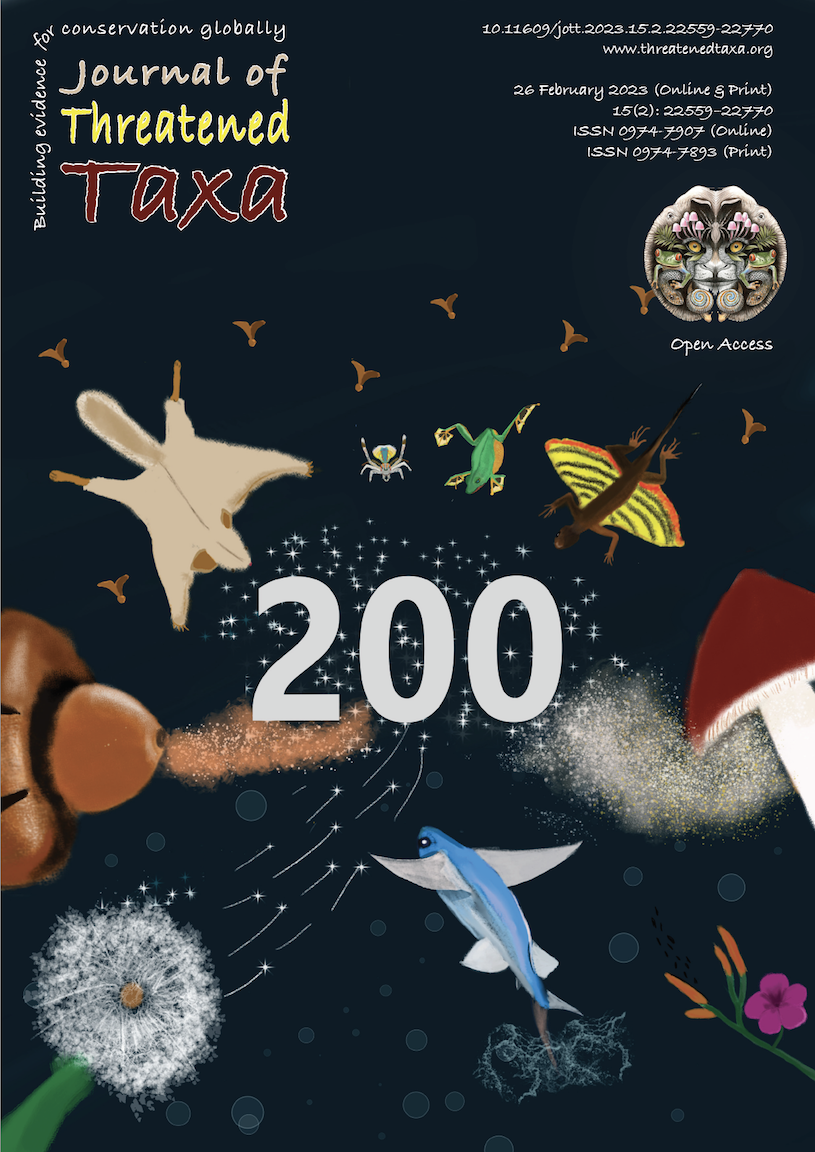Differential kleptoparasitic interactions of Himalayan Vulture Gyps himalayensis with conspecifics and heterospecifics during various stages of breeding
DOI:
https://doi.org/10.11609/jott.8172.15.2.22606-22610Keywords:
Himalaya, Hirpora Wildlife Sanctuary, Kashmir, Kleptoparasitism, nest, vultureAbstract
Reports of kleptoparasitic events involving Gyps himalayensis (Himalayan Vulture) are limited. In this article we document intraspecific and interspecific kleptoparasitic interactions at nesting sites, and analyse factors influencing this behaviour. The study was carried out at Hirpora Wildlife Sanctuary of Kashmir Himalaya, at an elevation of about 2,546 m. We observed 61 instances of food theft involving conspecifics (n = 12) and heterospecifics (n = 49). The highest number of incidents were observed during the chick rearing period (n=40), followed by incubation (n = 10) and pre-laying periods (n = 5). We observed the highest number of attacks at nesting sites (n = 30) and the lowest in flight (n = 9).
References
Bautista, L.M., J.C. Alonso & J.A. Alonso (1998). Foraging site displacement in Common Crane flocks. Animal Behaviour 56: 1237–1243.
Brockmann, H.J. & C.J. Barnard (1979). Kleptoparasitism in birds. Animal Behaviour 27: 487–514.
Dekker, D., M. Out, M. Tabak & R. Ydenberg (2012).The effect of kleptoparasitic bald eagles and gyrfalcons on the kill rate of peregrine falcons hunting dunlins wintering in British Columbia. Condor 114(2): 290–294.
Donázar, J.A., F. Hiraldo, F. & J. Bustamante (1993). Factors influencing nest site selection, breeding density and breeding success in the bearded vulture (Gypaetus barbatus). Journal of Applied Ecology 30: 504–514.
Fisher, D.L. (1985). Piracy behavior of wintering Bald Eagles. Condor 87: 246–251
Grimmett, R., C. Inskipp & T. Inskipp (2016). Birds of Indian Subcontinent. Bloomsbury publishing India, 528 pp.
Hadjichrysanthou, C., M. Broom & J. Rychtář (2018). Models of kleptoparasitism on networks: the effect of population structure on food stealing behaviour. Journal of Mathematical Biology 76: 1465–1488. https://doi.org/10.1007/s00285-017-1177-7
Hamilton, I.M. (2002). Kleptoparasitism and the distribution of unequal competitors. Behavioural Ecology 13(2): 260–267
Heredia, B. (Eds.) (1991). El plan coordinado de actuaciones para la protecci6n del quebrantahuesos. El quebrantahuesos (Gypaetus barbatus) en los Pirineos, 126pp.
Iyengar (2008). Kleptoparasitic interactions throughout the animal kingdom and a-re-evaluation, based on participant mobility, of the conditions promoting the evolution of kleptoparasitism. Biological Journal of the Linnean Society 93: 745–762.
John, J.R.M & W.S. Lee (2019). Kleptoparasitism of Shoebills Balaeniceps rex by African Fish Eagles Haliaeetus vocifer in Western Tanzania. Tanzania Journal of Science 45(2): 131–143.
Margalida, A. & J. Bertran (2000). Breeding behaviour of the Bearded Vulture Gypaetus barbatus- minimal sexual differences in parental activities. Ibis 142: 225
Margalida, A. & J. Bertran (2001). Function and temporal variation in use of ossuaries by Bearded Vultures (Gypaetus barbatus) during the nestling period. Auk 118: 785–789.
Margalida, A. & J. Bertran (2003). Interspecific and intraspecific kleptoparasitic interactions of the bearded vulture (Gypaetus barbatus) at nesting areas. Journal of Raptor Research 37: 157–160.
Margalilda, A. & R. Heredia (2002). Interspecific interaction between Lammergeier Gypaetus barbatus and Black Vulture Aegypius monachus: predation or kleptoparasitism? Sandgrouse 24: 138–139
Moreno-Opo, R., A. Trujillano & A. Margalida (2020). Larger size and older age confer competitive advantage: dominance hierarchy within European vulture guild. Scientific Reports 10, 2430 (2020). https://doi.org/10.1038/s41598-020-59387-4
Mullers, R.H.E. & A. Amar (2015). Shoebill Balaenicpes rex foraging behaviour in the Bangweulu Wetlands, Zambia. Ostrich 86(1&2): 113–118
Mundy, P., D. Butchart, J. Ledger & S. Piper (1992).The vultures of Africa. Acorn Books & Russel Friedman Books, Randburg and Halfway, 100 pp.
Mushtaq, H. (2020). Bioecology and conservation status of vultures in Hirpora Wildlife Sanctuary of Kashmir Himalaya. Ph.D. Thesis. Department of Zoology, University of Kashmir, 121 pp.
Navaneethan, B., K. Kalyansundaram Sankar, Q. Qureshi & M. Manjrekar (2015). The Status of Vultures in Bandhavgarh Tiger Reserve, Madhya Pradesh, Central India. Journal of Threatened Taxa 7(14): 8134–8138. https://doi.org/10.11609/jott.2428.7.14.8134-8138
Negro, J.J., A. Margalida, F. Hiraldo, & R. Heredia (1999). The function of cosmetic coloration of Bearded Vultures: when art imitates life. Animal Behaviour 58: F14–F17
Rodríguez-Estrella, R. & L.B. Rivera-Rodríguez (1992). Kleptoparasitism and other interactions of Crested Caracara in the Cape region, Baja California, Mexico. Journal of Field Ornithology 63: 177–180.
Ryan, F.B., B.L. Joiner & A.T. Ryan (1992).MINITAB Handbook. Boston PWS-KENT Publishing Company, 376 pp.
Wani, H.M., M.F. Fazili & R. Ahmad (2021). Seasonal habitat selection of Gypshimalayensis in Hirpora Wildlife Sanctuary, Jammu and Kashmir. Indian Journal of Ecology 48(2): 524–529.
Wani, H.M., M.F. Fazili, S.A. Charoo, B.A. Bhat & R.A. Bhat (2020). Evaluating population, threats and peoples attitude in relation to Himalayan vulture (Gyps himalayensis) in Hirpora Wildlife Sanctuary, Kashmir: A call for conservation. Indian forester 146 (10): 932–937. https//doi.org/10.36808/if/2020/v146i10/153858
Published
Versions
- 26-02-2023 (2)
- 26-02-2023 (1)
Issue
Section
License
Copyright (c) 2023 Hameem Mushtaq Wani

This work is licensed under a Creative Commons Attribution 4.0 International License.
Authors own the copyright to the articles published in JoTT. This is indicated explicitly in each publication. The authors grant permission to the publisher Wildlife Information Liaison Development (WILD) Society to publish the article in the Journal of Threatened Taxa. The authors recognize WILD as the original publisher, and to sell hard copies of the Journal and article to any buyer. JoTT is registered under the Creative Commons Attribution 4.0 International License (CC BY), which allows authors to retain copyright ownership. Under this license the authors allow anyone to download, cite, use the data, modify, reprint, copy and distribute provided the authors and source of publication are credited through appropriate citations (e.g., Son et al. (2016). Bats (Mammalia: Chiroptera) of the southeastern Truong Son Mountains, Quang Ngai Province, Vietnam. Journal of Threatened Taxa 8(7): 8953–8969. https://doi.org/10.11609/jott.2785.8.7.8953-8969). Users of the data do not require specific permission from the authors or the publisher.





